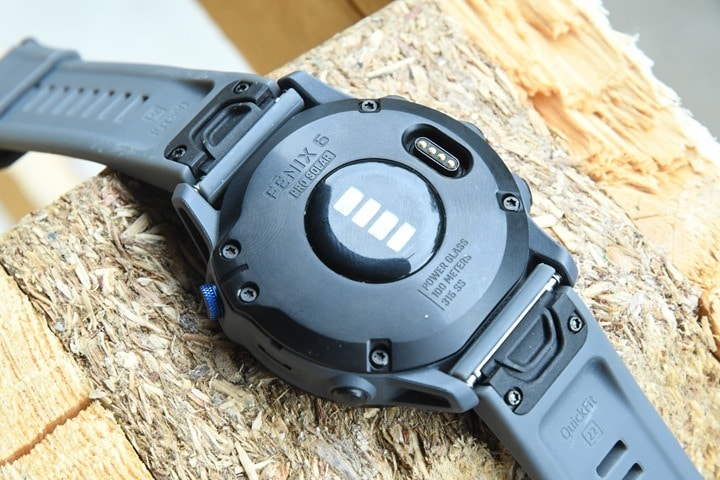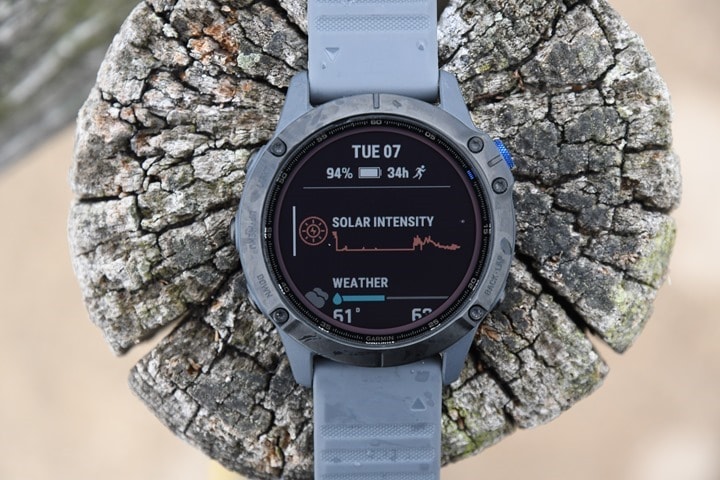
Today Garmin has extended the solar option on the Fenix 6 series to include the Fenix 6S Pro and Fenix 6 Pro units, completing the family that started last year with the Fenix 6X Pro Solar. Now all three Pro units offer a solar-equipped option. In addition, Garmin also announced a new Garmin Instinct Solar lineup too. Beyond adding in solar panel tech, the watches also get some new features such as Indoor Climbing and Bouldering, as well as a new surfing integration with Surfline sessions.
Now, for this review, I’m truncating it to focus on the aspects that are new or different. While I’ve been using these units for about a month now, the reality is that almost no aspects of them are different than the existing Fenix 6 Pro series…except the solar panel pieces. In addition to the new software bits that have largely been available in beta on the existing Fenix 6 series watches for the past month (such as the new sleep tracking and heart rate broadcasting bits).
Point being, while I could re-write an entire review talking about basics like step tracking and how to configure sport data pages, or how to sync to Spotify – I’ve already done that. And nothing has changed in those areas. That’s all the same. And in using these watches on my wrist 24×7 since then – I can confirm no differences between a non-Solar Fenix 6 Pro and a Solar Fenix 6 Pro in those areas. In fact, even the GPS & HR accuracy aspects haven’t really changed – but I love some accuracy charts – so you’ll get those down below for fun.
With that, let’s dive into it!
What’s new:

Now, there’s actually more to the Fenix 6 Pro Solar units than just a touch bit of solar panel. There’s also some new software features. But fear not, these non-solar specific features are also being added to all Fenix 6 series units. But, to recap everything that’s new there’s:
– Added under-glass solar panel to Fenix 6S Pro & Fenix 6 Pro
– Added around the edge solar panel to Fenix 6S Pro & Fenix 6 Pro
– Added Mountain Bike Grit & Flow metrics (previously launched on Edge 530/830)
– Added Indoor Climb activity profile: Tracks indoor climbing metrics (more on this in a second)
– Added Bouldering activity profile (indoors): Tracks
– Added new Surfing activity profile with Surfline Sessions to create videos with data overlays
Oh –and just in case you missed it above: Yes, all those new software features are coming to the Fenix 6 series in the next firmware update.
Doing a quick lap around through each of the new non-solar aspects (since the entire next section is solar focused), first up is mountain bike Grit and Flow. For those that put on their Garmin Edge cap, you’ll remember they came out last spring with the Edge 530 and Edge 830. The Edge 1030 got them in a firmware update, then the Edge 1030 Plus and even Edge 130 Plus a few weeks back.
On the watch, you’ll select the mountain bike profile (it’s not enabled by default, so you’ll want to add it from the sports menu). Then, you’ll need to go and add these fields to your data fields. That’s kinda weird, since on a Garmin Edge device it adds these automatically. In any case, you’ll find them under the ‘Other’ bucket:
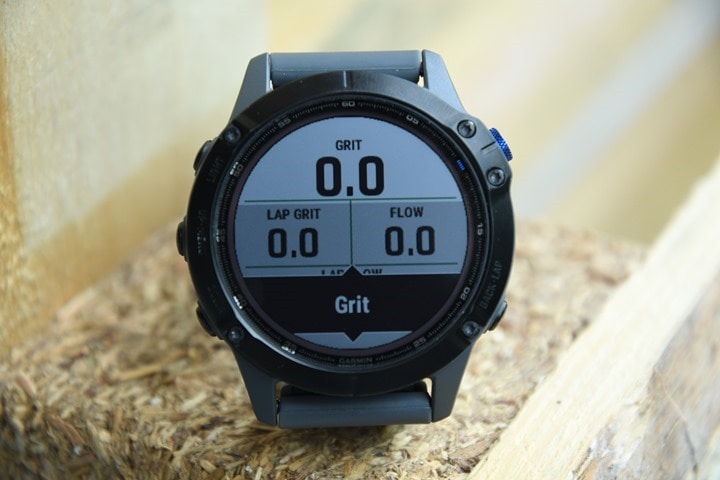
There’s Grit, Lap Grit, Flow, and Lap Flow. Here’s what they look like added to a single page:
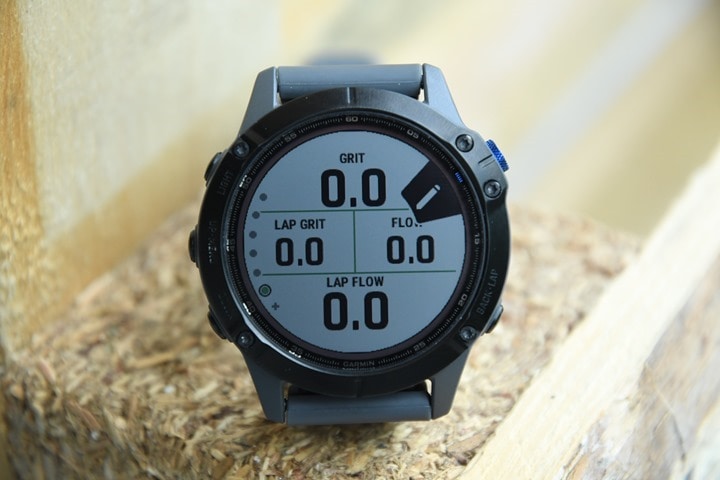
Then, go out and ride. I haven’t had any good mountain bike chances as of late. But, here’s what the data will look like after the fact:
Next, down below in the charts section they show up there too, also color coded:

Note however, that there’s a slight difference to the Garmin Edge units – notably that they don’t include jump counting in the Fenix metrics. I suspect that’s because with your hands potentially flapping around that’d dork up the accelerometer/gyro data (whereas an Edge is mounted to your bike – and ideally not flapping its wings mid-flight).
Next there’s the new Indoor Climbing and Bouldering profiles.
In case you’re wondering what the difference is, essentially Indoor Climbing you use ropes to get to the top, whereas Bouldering is typically tops out at lower heights (max 3-4 meters), so you’d do it without ropes. You can read this to understand the nuances.
Indoor Climbing Activity Profile:
When you first begin an Indoor Climb workout, it’ll ask whether you’d like to track the route stats. Again, this is all indoors, so it’s not using GPS. When you choose yes, you’ll then select which grading system to use.
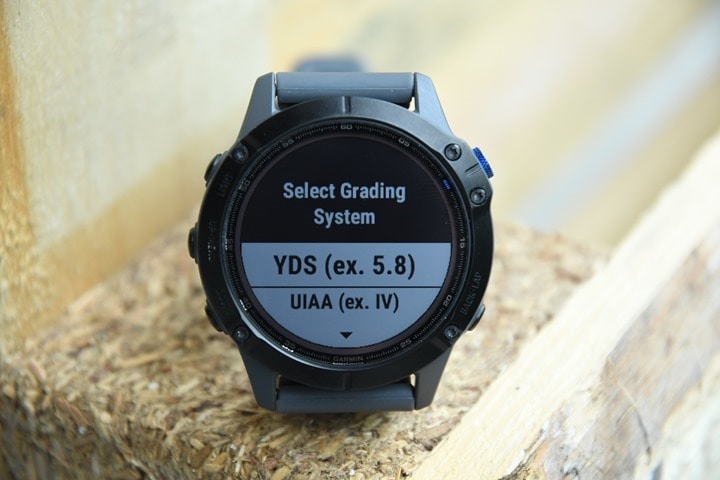
In total there’s YDS, UIAA, French, British Adj., British Tech, Ewbank, Brazilian, and Saxon. You can change this mid-activity as well within the Climbing Profile settings.
Once you’ve selected a grading system, you’ll then select the difficulty:

At this point the watch is ready to begin (after you press start). It’ll track time, total ascent, and heart rate on one screen (plus showing you the difficulty at the top).

There’s also then a page for Last route:
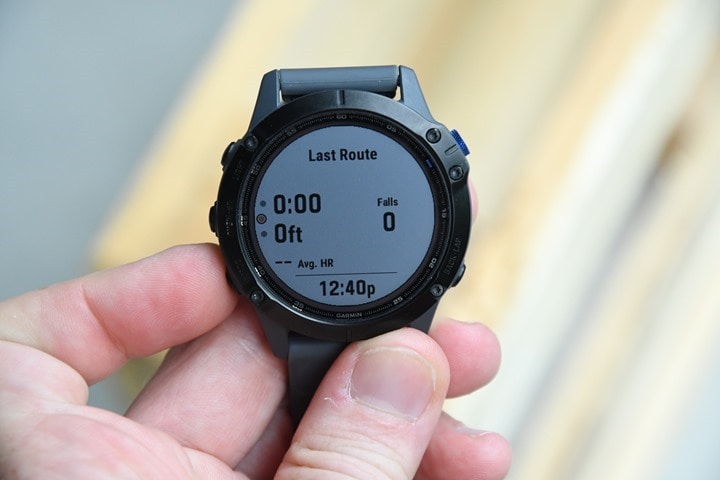
As well as a page for total routes:

Once you’ve completed the route you’ll hit the lap key to mark it as complete. After which it’ll ask if you’ve had any falls. From there it’ll go into a rest screen and wait for your next climb to begin (when you hit the lap marker). In that sense it’s kinda like the indoor pool swimming with sets.
Afterwards on Garmin Connect it’ll show you a breakdown of the details. And of course it’ll sync that off to 3rd party apps/platforms like Strava/etc…though, those don’t support all these metrics, so ultimately it’ll be pretty limited in what you see on 3rd party sites.
Bouldering Activity Profile:
Next, the Bouldering activity profile is pretty similar to that of the Indoor climbing one.
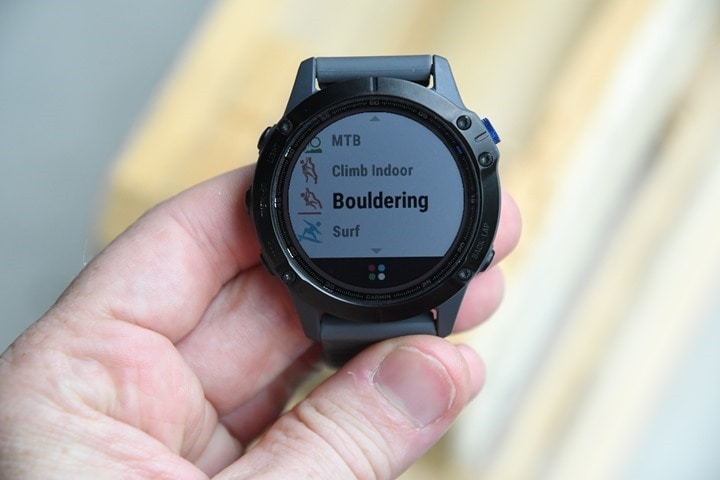
First you’ll select the grading system, in this case it supports V-Scale, Font, and Dankyu:
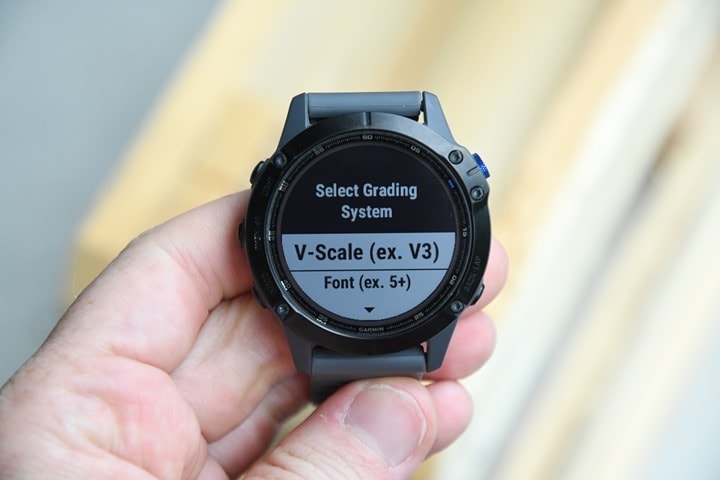
Next, you’ll select the difficulty of the problem you’re about to climb. The exact min/max levels it supports will vary based on which grading system you’re using:
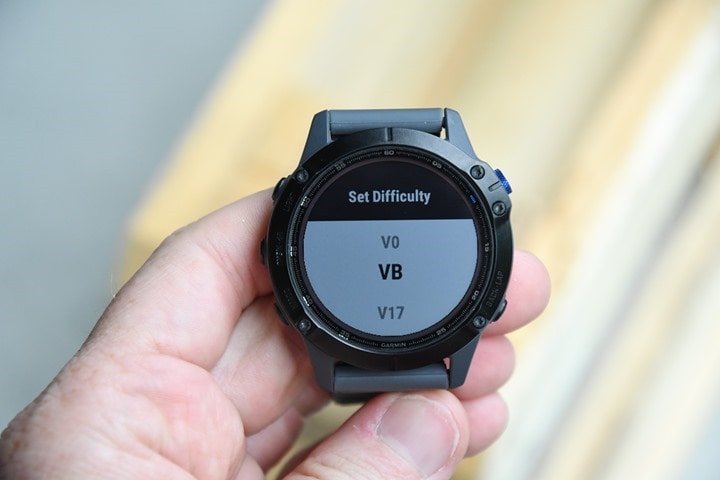
Once ready to climb it’ll show you the problem difficulty at the top, the time, and you’re heart rate:

After you’ve finished climbing the route you’ll press the lap key just like with indoor climbing. This will then give you three options: Mark route as completed, mark as attempted, or discard the whole chicken. Like with indoor climbing you can see both the last route and total route data:
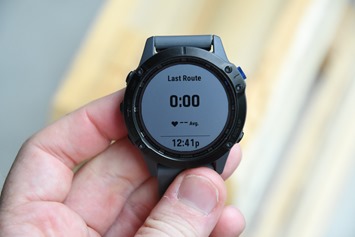
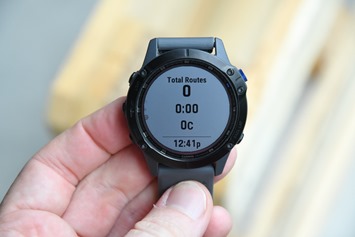
I’m not exactly a climber, however, DesFit did get the chance to try this part out – so if that’s your cup of tea, hit up his video on it.
That said, ironically, by pure coincidence I stumbled upon a brand new facility that just opened up a mere 3 minute pedal from me. So far I’ve just been a stalker and looked through the windows – but maybe I’ll give it a poke.
Surfing profile with Surfline integration:
Finally, there’s the new surfing profile data metrics with Surfline integration. You may have seen the surfing metrics added as part of the more recent Garmin Fenix 6 betas, in fact, they were actually looking for people to beta test it (which, by the looks of it was pretty limited in finding people).
In any case, the way it works is that you’ll first open the surf activity profile, and then it’ll track the waves surfed, maximum speed reached, and distance travelled within the profile.
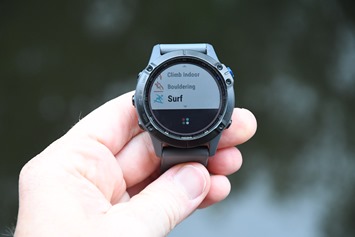
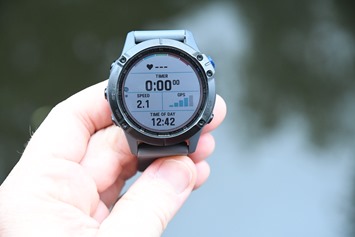
What’s really interesting here though is Garmin is integrating with Surfline for data overlays with video integration. Surfline is a surfing site that you can lookup tons of data about nearby spots. Wave conditions and such. However, in addition to that they’ve got some 400 cameras pointed at waves that are recording to the cloud. Currently they have an Apple Watch app that allows you to record your sessions on the watch, and then later on the site will find the exact video clips of you by cross-referencing the time stamps and GPS data.

So, with the Fenix integration that’s all supposed to work in the same manner. However, there’s no Surfline cameras anywhere near me (or even remotely near me). The nearest appears to be on the other side of the English channel. But…at least it looks pretty there:

In any case, I’m definitely the wrong person to test this bit out. But it does show Garmin’s ever-expanding sport profiles, and specifically having actual data for those profiles. While some runners or cyclists may be like ‘That’s a useless feature…to me’, the thing Garmin has figured out that most other companies haven’t is that one person’s useless feature is another person’s most important feature.
There’s currently surf watches in the market already, so clearly there’s demand there. From Garmin’s perspective it’s relatively trivial to take an existing piece of hardware and add a few extra metrics. Whereas the lift for a new company to create a new smartwatch in 2020 is almost impossibly hard to get enough demand to make it work.
In any case, if you’ve got a Fenix 6 series watch, you can test this feature out today via the beta. Or, simply wait for it to hit production probably any day now.
Solar & Battery Details:
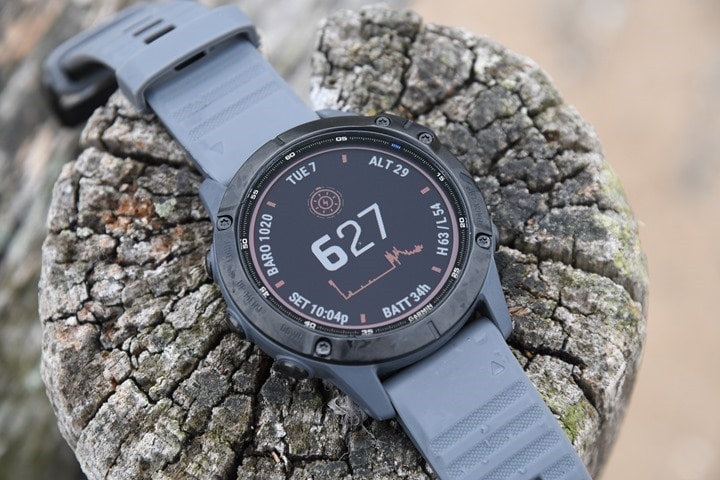
When it comes to the Solar aspects added to the Fenix 6 & 6S, they’re basically identical to that of the Fenix 6X Solar that was launched last summer. Whereas if you looked at the new Garmin Instinct Solar units, those have a different panel arrangement than the Fenix series.
Now, as you may remember from my review last year, Garmin often sees the ‘X’ variant of the Fenix as a place to trial out new technologies before introducing them elsewhere. Last year, that was solar with the Fenix 6X Solar, whereas this year that’s being added to multiple units. The solar pieces all comes from an acquisition of technologies from French company SunPartner Technologies. Garmin actually quietly made that acquisition back when the company filed for insolvency, a long time before they announced it in the Fenix 6X Solar last year.
On all of the solar-enabled Fenix 6 units you’ll notice a very thin 1mm wide strip just on the inside of the bezel. This is the first of two solar pieces.

This thin strip has 100% photovoltaic levels, meaning, it’s receiving 100% of the sun’s goodness and turning that into solar power. It’s also clearly visible in bright light, though you’d just assume it was a bezel design element. Inside without bright light, this strip almost disappears and blends into the bezel.
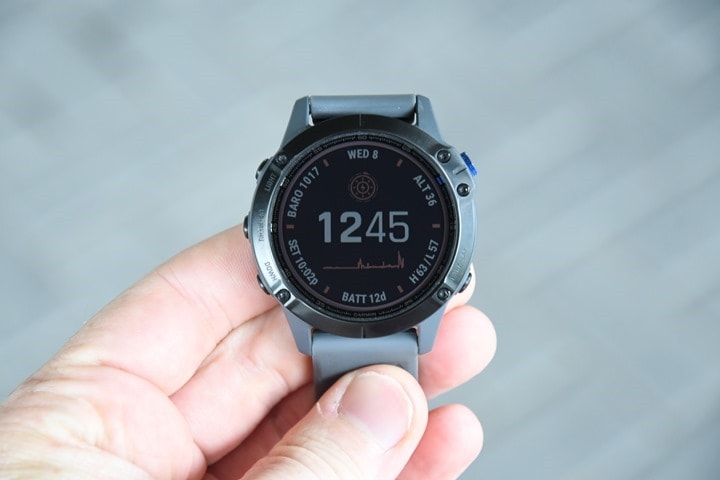
However, there’s a second solar panel you can’t see – despite being the entire display face. Under the display is another solar panel that has a 10% photovoltaic level. This panel is of course far larger than that of the thin bezel strip, but is also getting 10% of the sun’s rays, due to the display blocking much of it. Importantly though, both panels are fully under a single sheet of Gorilla Glass (specifically Corning Gorilla Glass 3 with DX Coating). Meaning, you won’t accidentally scratch the bezel solar panel anymore than you’d normally scratch your watch face.
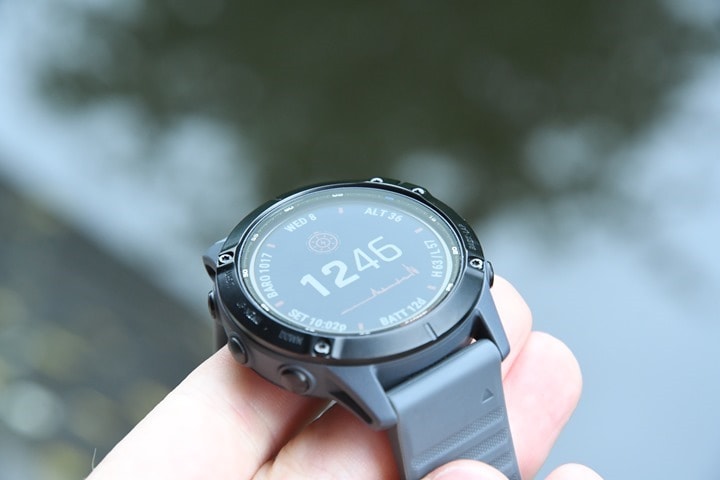
Speaking of that watch face, you’ll notice that there’s a little sun atop the default watch face. That sun is actually showing you the current intensity level. Around the edge of the little sun are 10 pieces, each indicating 10% of full intensity. So if you look at the below picture you’ll see the sun is coming in at 0% intensity as I’m in the shade:

Next, another phone out in some broken clouds conditions and you can see it’s at about 70%:
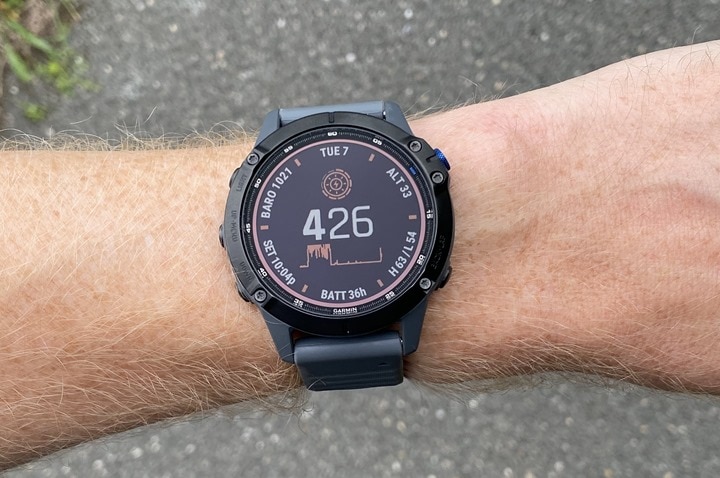
And here’s another at 100% intensity, with all lines lit up as well as the sun itself:
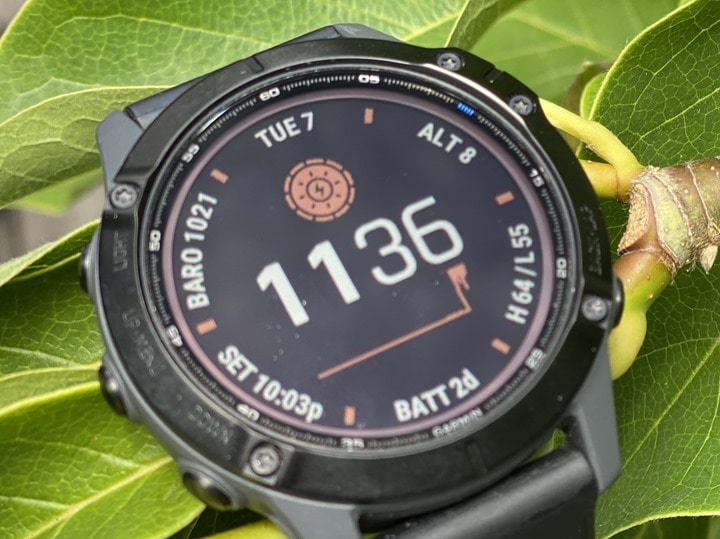
You can also see this in the Widget Glances too:
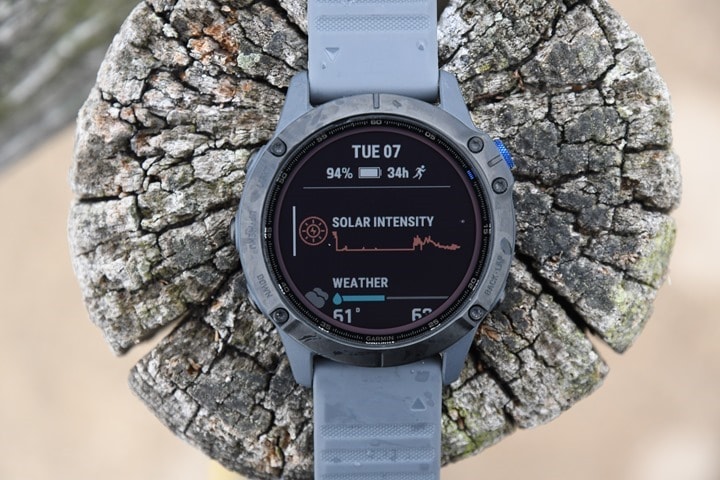
And then a plot over the last 6 hours of activity as well:
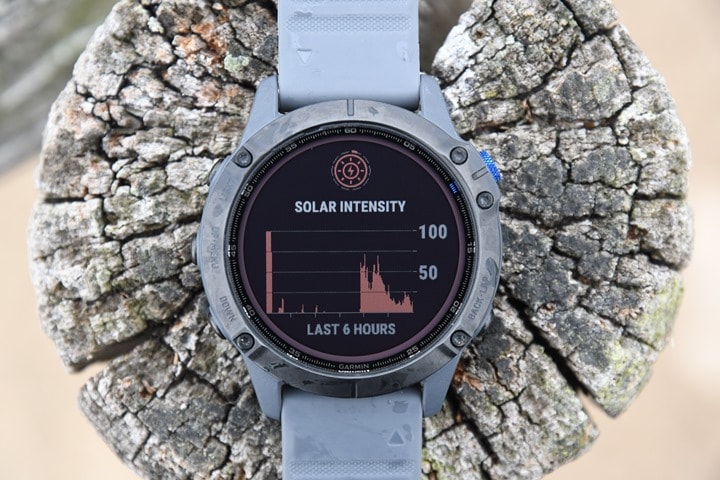
In addition, you can look back at any day of history you want to via Garmin Connect Mobile:
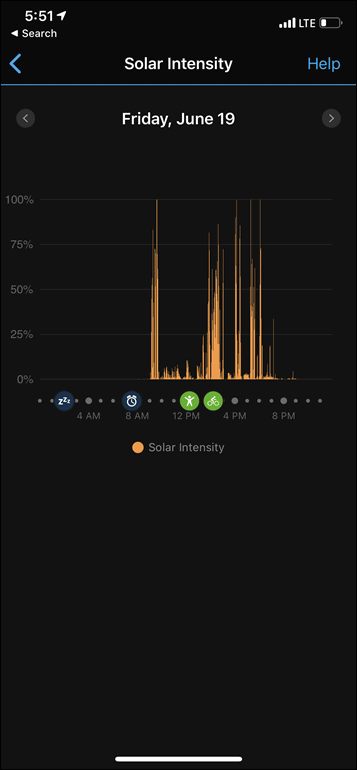
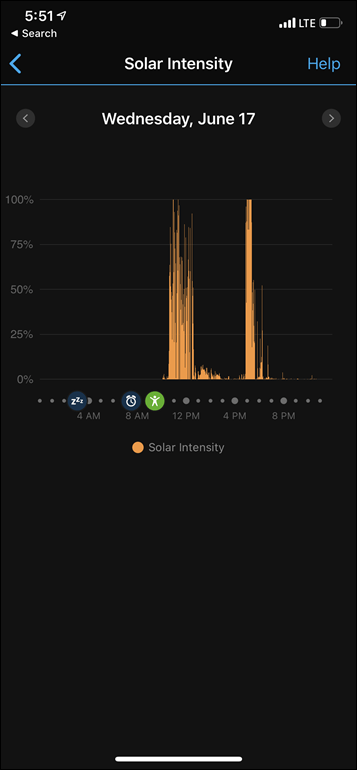
The goal of the solar here isn’t to fully power the watch, under GPS or otherwise. Instead, it’s to provide incremental battery life (more on my testing on this in a second). Garmin notes this in their super-detailed battery life chart. Note specifically the assumption of 3 hours per day of solar light at a pretty high intensity (full sun basically). That goes both ways though. If you’re mid-summer and spending the day at the beach (or workout side), then you’ll way overachieve here. Versus if it’s mid-winter and you’re indoors…then not so much.

*Assumes all-day wear with 3 hours per day in 50,000 lux conditions
**Assumes use in 50,000 lux conditions
Wait, so what’s 50,000 lux you ask? It’s a pretty sunny day, though, not living in Arizona in summer kinda sunny. Here’s what Wikipedia says about it:

Now Garmin doesn’t ever show lux levels in the solar widgets. Instead, they show a relative intensity in terms of solar power. On a pure sunny day here in July in the Netherlands, I easily can get the full sun widget to illuminate. But, I can also do that too even on a high light overcast day (meaning, a super high thin cloud layer). Even with a handful of clouds meandering around.
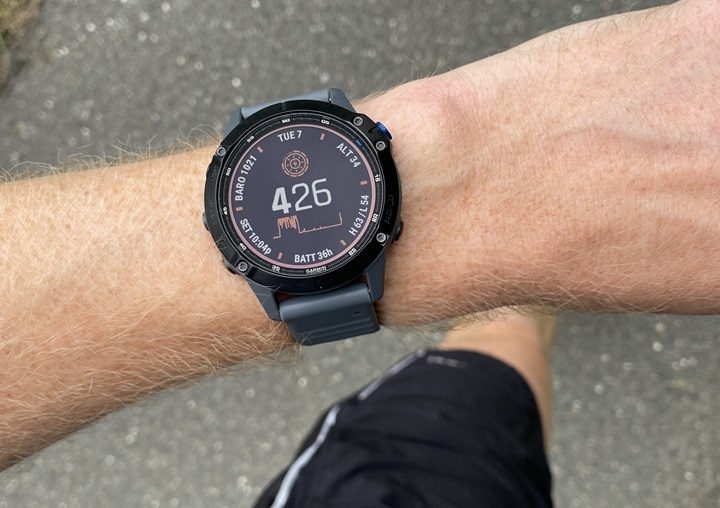
Meanwhile, for a portion of my hike when it was raining I was getting anywhere between 20-50% solar intensity levels, depending on the specific cloud passing by. Point is, it’s not as drastic as you’d think.
Here’s the basic main takeaways though:
A) If you’re spending 3+ hours outdoors (non-workout mode) you might be able to pull off something close to battery neutral in a pared down configuration (not much notifications/etc…).
B) While outdoors on longer hikes in significant sun, solar will definitely extend your battery life, potentially a lot. Or potentially not at all.
In order to test this, I went out for a longer hike/walk thing yesterday. For this test I compared a Fenix 6 Pro with a Fenix 6 Pro Solar, identically configured with every possible setting I could find. The theory was to wander for about 3 hours in the sun in reasonably wide open areas (dunes mostly), but of course, the weather dorked with my plans, so it starts off sunny and then eventually got a bit rainy.
Here’s the battery burn charts for the meander:

As you can see, it’s basically impossible to tell the difference between the two Fenix units, even after 3 hours. I’m sure brighter sun would have helped the Fenix, though in looking at some other 1-2 hour activities it hasn’t varied a ton either. The nuance between the burn rates at that point is really challenging.
In talking with Garmin about battery burn rates recorded to files, that in general you’ll get more concrete results with longer activities than shorter ones. Also, because of the frequency in which the battery value is updated, a few seconds one way or the other when we’re talking 0.08% difference can result in a big swing (since it’s only recorded at whole numbers). That’s fair, and is pretty common for any battery technology that if you really want to get a good idea of the battery burn rates that you need to measure longer periods of time.
And if we look at a longer hike I did last summer with the Fenix 6X Solar and Fenix 6 non-solar side by side, you can see the impact of the battery burn rate once I hit the sun coming out of the tree line. When I’m below the tree-line in the trees (up till about 1hr 30mins), you can see battery burn rate is about equal, but once I clear the tree-line (around 1hr 30 marker), and am back into the sun, battery life burn on the 6X Solar slows. Pretty cool. Note that in that case we want to ignore the slope of the non-Solar unit, since it has a smaller battery, but instead not the significant difference between those out once out of the sun.

By the way, those battery charts are with the DCR Analyzer. We plot battery life for devices that support writing it to the files, including Garmin, Wahoo, and Stages.
Now, it’s important to note that this won’t actually power up the watch any from dead, at least not in any meaningful way. Last summer I tried this when I left a Fenix 6X Solar atop an RV out in a field for 12 hours. It was totally dead when I placed it out there – 0% battery. When I returned after a day of strong bluebird sky sun without a single cloud, it was still powered off. However, upon powering it back on it found itself 4% battery.
It’s also at this juncture that I realized I apparently never edited that video that I shot for it. Huh.
Similarly, today in the morning while it was nice and sunny without clouds I stuck a watch on a tree branch with no branches above it. This time it was powered on, with full sun. When I returned about 65 minutes later, the battery hadn’t increased at all – still 16%.
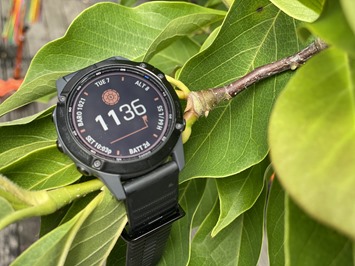
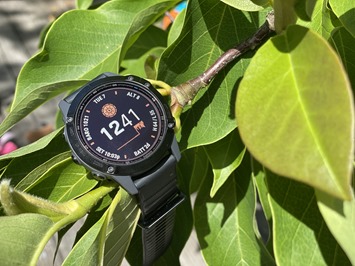
Of course, that’s likely not long enough – especially when balanced out by notifications coming in (but no GPS on). Certainly you can get a small increase in battery life from a number of hours outside as Garmin indicates. People have seen it. But my point here is expect it to be somewhat minimal.
Compare this with something like the Casio GBD-H1000 GPS, which can easily power up from dead to not dead using just solar panel in a relatively short amount of time (couple hours at most), and actually get sustainable solar power from the panels. Not enough to last forever doing GPS activities, but certainly plenty to meaningfully help when hanging outside on a sunny day not recording.
Of course, that’s a different beast of a watch, and the more I use it, the more I realize there’s really not much real-world overlap with either the Fenix 6 or Instinct. After all, it only has a single sport mode: Outdoor run, and no method to set any other mode. Plus, it’s clear that Casio isn’t trying to hide the solar panels, rather it becomes part of the aesthetic.
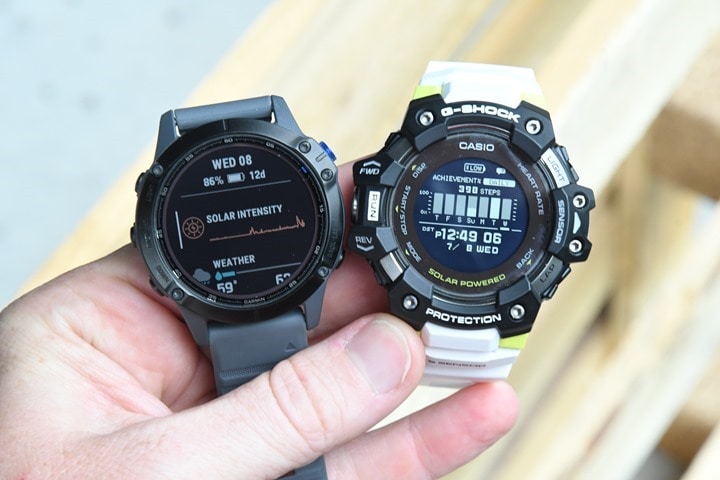
Whereas Garmin seems to aim to make it such that you’d never notice the panels if you didn’t explicitly know they were there, and where they were. Different strokes for different folks. But, at the same time, I’m hoping we’ll see more gains from Garmin in the future.
They did note that the Fenix 6/6S/6X Solar and Instinct Solar would all be considered from the same solar panel technology “generation”.
GPS Accuracy:
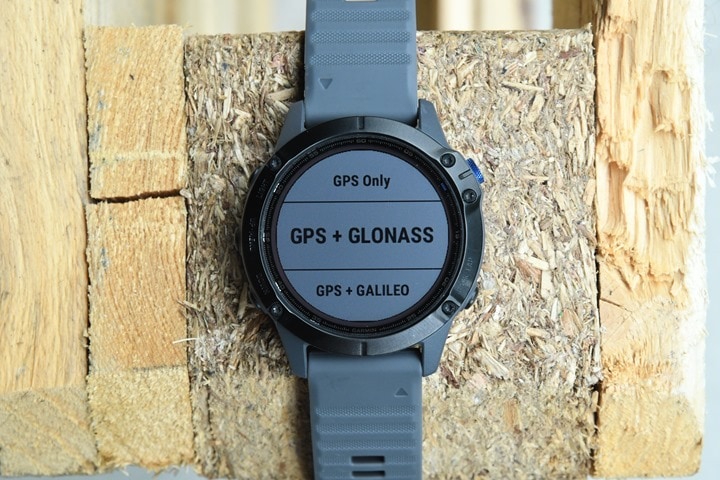
There’s likely no topic that stirs as much discussion and passion as GPS accuracy. A watch could fall apart and give you dire electrical shocks while doing so, but if it shows you on the wrong side of the road? Oh hell no, bring on the fury of the internet!
GPS accuracy can be looked at in a number of different ways, but I prefer to look at it using a number of devices in real-world scenarios across a vast number of activities. I use 2-6 other devices at once, trying to get a clear picture of how a given set of devices handles conditions on a certain day. Conditions include everything from tree/building cover to weather.
Over the years, I’ve continued to tweak my GPS testing methodology. For example, I try to not place two units next to each other on my wrists, as that can impact signal. If I do so, I’ll put a thin fabric spacer of about 1”/3cm between them (I didn’t do that on any of my Instinct activities however, all workouts only had a single device per wrist). But often I’ll simply carry other units by the straps, or attach them to the shoulder straps of my hydration backpack. Plus, wearing multiple watches on the same wrist is well known to impact optical HR accuracy.
Next, as noted, I use just my daily training routes. Using a single route over and over again isn’t really indicative of real-world conditions, it’s just indicative of one trail. The workouts you see here are just my normal daily workouts.
First up we’ll start with something relatively easy, my 10-mile hike yesterday. The goal of this was mostly to stay in open-air areas to get more solar power. Still, there was a wooded section the last mile or so. Here’s that data set. This set included a Polar Grit X, Garmin Instinct, Instinct Solar, Fenix 6 Pro, and Fenix 6 Pro Solar.
![image_thumb[9] image_thumb[9]](http://media.dcrainmaker.com/images/2020/07/image_thumb9_thumb.png)
For the first couple kilometers, all the units were basically identical. Again, there’s basically nothing out here to obstruct the GPS view:
![image_thumb[13] image_thumb[13]](http://media.dcrainmaker.com/images/2020/07/image_thumb13_thumb.png)
Then, I got to the beach area. Along the waterfront there are actually tall apartment/hotel buildings that I came relatively close too. But there was no meaningful impact to GPS accuracy on any of the units:
![image_thumb[15] image_thumb[15]](http://media.dcrainmaker.com/images/2020/07/image_thumb15_thumb.png)
Then it was off into the dunes for a bit. And again, all super boring here:
![image_thumb[17] image_thumb[17]](http://media.dcrainmaker.com/images/2020/07/image_thumb17_thumb.png)
As I got into the trees, I started seeing a tiny bit of variation between the units. But we’re basically talking 2-3 meters difference offset from the path. And it varied which units were most accurate. In general the two Instinct units seemed nearest the track most times. All units were configured with the same GPS+GLONASS.
![image_thumb[24] image_thumb[24]](http://media.dcrainmaker.com/images/2020/07/image_thumb24_thumb.png)
![image_thumb[25] image_thumb[25]](http://media.dcrainmaker.com/images/2020/07/image_thumb25_thumb.png)
However, I do want to briefly note that with about 100m to go, the Instinct Solar restarted randomly. It didn’t lose any GPS track data, and allowed me to resume. But it oddly added nearly about a mile (~1.5km) to the summary distance with no reason. It also added 15 minutes. Neither of these make any sense, and Garmin is looking into it. It didn’t impact the GPS track, but just the total value shown on the unit and in Garmin Connect.
![image_thumb[27] image_thumb[27]](http://media.dcrainmaker.com/images/2020/07/image_thumb27_thumb.png)
So ultimately, while GPS accuracy was pretty good, the restart gave me extra credit for no reason.
Next we’ve got a more city-focused run, including going through some buildings. For this one I had with my a Instinct Solar, Casio GBD-1000, Polar Grit X, Fenix 6 Pro Solar, and Forerunner 935. Here’s that data set:
![image_thumb[29] image_thumb[29]](http://media.dcrainmaker.com/images/2020/07/image_thumb29_thumb.png)
The Casio oddly had GPS lock, showed GPS, started with GPS lock…but then decided against recording the first mile or so of GPS data to the file. I’m not sure why it was upset. You see it start mid-way through the run, above, in the middle of a pond.
In any event, zooming into the park portion first (which is mostly under tree cover this time of year), you’ll see that the Instinct Solar and Grit X were probably closest to the path on the southern side (but was a bit more wobbly on the northern side straightaway). The Fenix 6 Pro Solar was pretty darn smooth on both sides. The Casio seemed a bit drunk on the turns, but was mostly fine for the straightaways.
![image_thumb[31] image_thumb[31]](http://media.dcrainmaker.com/images/2020/07/image_thumb31_thumb.png)
Next, are some buildings. This included running down a street with 5-6 story buildings on both sides (shown at left below). The Garmin/Polar units nailed this, spot on. The Casio…went shopping. Also, for those curious – the Casio was on my right wrist, and the Instinct Solar on my left wrist. The other units were all on the handlebar of the running stroller.
![image_thumb[33] image_thumb[33]](http://media.dcrainmaker.com/images/2020/07/image_thumb33_thumb.png)
Also of note above is that I went through the Rijksmuseum, and most of the watches were pretty good at that. It’s probably 100-125m long of no GPS signal under a massive building. The Instinct Solar slightly cut the corner towards the end, but otherwise it was reasonably clean.
This next section I ran twice, so it looks a bit crowded, but it’s good to see how similar each unit was since I ran in the same spot each time. You see the Casio and FR935 are more variable, whereas the Fenix 6 Pro Solar, Polar Grit X, and Instinct Solar tended to be less variable.
![image_thumb[35] image_thumb[35]](http://media.dcrainmaker.com/images/2020/07/image_thumb35_thumb.png)
Finally, for summary stats, you can see those below. Note that the Casio doesn’t write the summary data to a file…because it actually doesn’t write any files. Instead, you have to download a file from Strava, and that file doesn’t include the summary data properly written (because Casio doesn’t send it).
![image_thumb[37] image_thumb[37]](http://media.dcrainmaker.com/images/2020/07/image_thumb37_thumb.png)
I’ve done piles more workouts with the Fenix 6 Pro Solar since early June. In fact, almost every workout you see on Strava since then has been with the Fenix 6 Pro Solar. Rides, runs, hikes, stand-up paddle boarding both in the forest and city – all that unit. For example, here’s a paddle with it around Amsterdam. You’ll see one spot where the two lines separate on the northern western edge. In that case, it’s because I had my board atop my wrist as I was portaging across a non-connecting canal. Whereas the Fenix 6 Pro (non-Solar) could see the sky, so the track there is more accurate. But that’s pretty reasonable.

In any case, I just don’t see any meaningful difference between the Solar variant of the Fenix 6 Pro and the non-Solar variant. Which is to say that for most people in most situations GPS accuracy will be just fine. Like with other watches, you’ll still see variations. Given all Garmin/Suunto/Polar/COROS units are using the same GPS chipset series from Sony, the accuracy tends to be pretty similar.
Wrap-Up:
After releasing the Fenix 6X Solar last summer, demand exceeded supply. And perhaps more challenging for Garmin, supply didn’t meet expectations. The company struggled through a fair chunk of Fall 2019 with yield related to the solar panel technologies. After all, it was their first watch incorporating the tech, and they needed to sort out the manufacturing side of things. But now, nearly a year later they’ve clearly done that. Supply is ample for the Fenix 6X Solar, and since then they’ve rolled out a Quatix edition watch with Solar, and now nearly a dozen Instinct Solar variants and a wide swath of Fenix 6S Pro and 6 Pro solar variants. Clearly, they’ve found their groove on this solar thing.
However, with the Fenix 6/6S/6X Pro Solar editions specifically, it’s hard to really see the benefit of solar in day to day situations. Sure, on bright sunny summer days with 8-10 hours of strong sunlight outdoor time you’ll definitely see a benefit. But, for the rest of the year, you probably won’t benefit much. And that’s somewhat to do with the fact that the Garmin Fenix series mostly tries to hide the solar panel. Compare that to the new Instinct Solar which is uses vastly more solar panel within the display to get nearly a 30% bump in GPS on-time, and an ‘Unlimited Power’ type mode in a battery-saving watch mode. I’d really like to see Garmin push the boundaries a bit more with the Fenix series.
Still – if you want the solar tech in a 6 or 6S form factor – it’s here now, and ready to roll. And, for everyone else that already has a Fenix 6 series, then you’ll benefit from all the new surf/sleep/climbing/bouldering features. So, seems to be win-win for now.
With that – thanks for reading!


